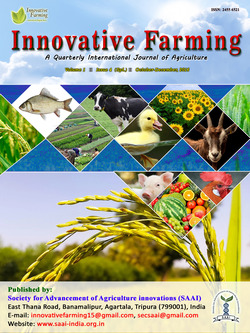
Assessment of Training Needs in Animal Husbandry Practices Among Non- Tribal Rural Women of Godda Through Various Attributes in Jharkhand
Satish Kumar*
G.V.T- Krishi Vigyan Kendra, GODDA, Jharkhand-814133, INDIA;
Shobha
Dept. of Economics, Ranchi College, Ranchi University, Ranchi, Jharkhand- 834006, INDIA;
Sujeet Kumar Yadav
Bhavdiya Educational Institute, Sewar, Sohawal, Faizabad -224126, U.P., INDIA
DOI: NIL
Keywords: Dairy, training, empowerment, rural women
Abstract
The present study was carried out on relationship of the selected non- tribal rural women with their training needs to animal husbandry practices in Godda district of Jharkhand and assessed the impact of interventions by both the Non-Government Organization (NGO) and District Administration of the state. Jharkhand is traditionally known as the mineral (40%) rich state of east India with dense forest area, accounting for about 3.4% forest area of India. Jharkhand state has less than 50% non-tribal population. Other backward classes, Scheduled Castes (SCs) and tribes (STs) together constitute more than 50% of the state’s population. Agricultural activities are counted as the main economic occupation of the state. About 75.95% of the population of the state are rural. This exploratory study was conducted in the non- tribal populated districts of Jharkhand state. Case study methodology for the purpose of the present study has been deliberately chosen so as to best understand and analyse the problems of non- tribal dairy farmers. 300 non- tribal dairy families were selected who were educated, trained and empowered by various NGOs and department of state Government of Jharkhand. Therefore concluded that majority of the respondents were falling under the category of low to medium level socio-economic standards, so appropriate policy implications has to be developed to enhance their standard of living and livelihood status.
Downloads
not found
Reference
Bariya, M.K., Kiran Chandravadiya , N.S. Joshi and G.P. Deshmukh. 2013. Relationship of rural women’s characteristics with their training needs in animal husbandry practices. Farming, 1(2):65-69.
Census India. 2015. Data Highlights: The Scheduled Tribes, Jharkhand state, Census of India. 2001, ttp://censusindia.gov.in/Tablespublished/SCST/dhstjharkhand.pdf.
JTDP. 2015. Jharkhand Tribal Development Programme. Tribal Development Society, Reaching the Poorest of the Poor. http://cjtdp.jh.gov.in/Projsummarye.htm. Accessed 20 May (2015).
Kumaresan, A., K.M. Bujarbaruah, K.A. Pathak, A. Das and R.K. Bardoloi. 2009. Integrated resourcegriven pig production systems in a mountainous area of North east India: production practices and pig performance. Tropical Animal Health and production, 41: 1187-1196.
Lanada, E.B., J.A. Lee, S.J. More, S. Basito and A. Taveros. 2005. A longitudinal study of sows and boars raised by smallholder farmers in the Philippines. Preventive Veterinary Medicine, 70: 95-113.
Lemke, U., B. Kaufmann, L.T. Thuy, K. Emrich and A. Valle Zarate. 2006. Evaluation of smallholder pig production system in North Vietnam. Agricultural Systems, 96: 207-223.
Meeta Punjabi. 2014. India: Increasing Demand Challenges the Dairy Sector. FAO. http://www.fao.org/docrep/011/i0588e/I0588E05.htm. Accessed 20 June (2014).
Moanaro, E. Ngullie, I. Walling, M. Krose and B.P. Bhatt. 2011. Traditional Animal Husbandary Practices in Tribal States of Eastern Himalaya, India: A Case Study. Indian Journal of Animal Nutrition, 28: 23-28.
Pandey, A.K. 1996. A Comparative Study of Livestock Rearing System among Tribal and Non-Tribal in Chotanagpur Region of Bihar. Ph.D. Thesis, National Dairy Research Institute (Deemed University), Karnal, Haryana.
Sanjeev Kumar, B.N. Dhananjaya and A.P. Singh. 2014. The Livelihood School, Milking the potentials: Study Report on Dairy Sub Sector in Chhattisgarh. http://www.cgsird.gov.in/dairysubsectorreportfinalsubmission.pdf. Accessed 10 May (2014).
Satish Kumar, Ritesh Dube and Neeraj. 2017. Constraints and prospects of traditional pig husbandry for tribal livelihood in jharkhand. Innovative Farming, 2(2):101-107.
Satish Kumar, Ritesh Dube, Shobha and Sujeet Kumar Yadav. 2018. Socio – Economic profile of tribal dairy farmers in Godda of Jharkhand. International Journal of Current Microbiology and Applied Sciences, 7: 2727-2733.
Senthil Kumar, R., Ramkumar, B.S. Meena, S. Subash and Asif Mohammad. 2012. Entrepreneurial Behaviour of Dairy Farmers. Indian Journal of Dairy Science, 65(1): 174-177.
Sharma, P.K., B.S. Shekhawat and M.K. Chaudhary. 2012. Knowledge of dairy farmers about improved animal husbandry practices in Kheda district of Gujrat. Journal Krishi Vigyan, 1: 49-53.
Srivastava, R.M. 1982. Cattle in Culture and Economy of Tribal Mundas of Bihar. Unpub. Ph.D. Thesis, Kurukshetra University, Kurukshetra, Haryana.
Subramanian, V. 1992. A study on the impact of milk producer’s cooperative societies in Thanjavur District, Unpub. M. V. Sc. Thesis, Tamil Nadu University of Veterinary and Animal Sciences, Chennai, Tamilnadu.
